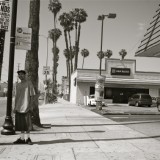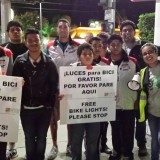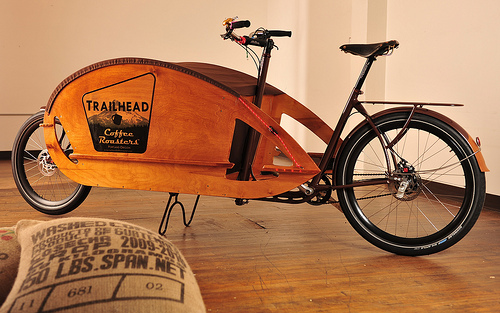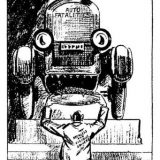
Hit and run accidents. Graph: AAA Foundation.
Reader Kyle says, “This will sound like a loaded question, but it is totally sincere: How much time do you spend cycling in the city? I tried re-taking up cycling as an adult in Seattle and it was terrifying, even in areas with clear bike lanes. In fact, I only cycled in areas with clear bike lanes….I had this vision that I would get comfortable enough that I would be able to cycle to my stable about 40 miles away via the trails paved over the old railway lines. My life changed and I ended up moving down there to shorten my commute, but cycling out here is very much an at-your-own-risk activity. But my experiment in Seattle failed. I was very much not comfortable on a bike, despite my grand vision of joining cycling culture and going all over the city without a car.”
A great question. The truth is that I spend less time cycling around Los Angeles than I did ten years ago. Partly, this is due to fewer family and work obligations. Kelly and I just don’t leave our neighborhood much anymore.
But there’s another reason I’m using my bike less and that’s because, like Kyle, I don’t feel safe. The carnage on our roads, after lessoning for many years, is back up. Hit and run accidents alone spiked by an astonishing 60% (see Hit-and-Run Deaths Are Skyrocketing, and Pedestrians and Cyclists Bear the Brunt in LA Streetsblog). Accident statistics related to cycling and walking are difficult to interpret as many incidents go unreported and police and the mainstream media often have a bias towards drivers. But the overall trend is not good. I’ve been hit by cars twice while riding a bike and Kelly got hit by a car while walking the dog last December.
While difficult to prove I believe we can blame the uptick in accidents on mobile devices. Combine those distracting devices with roads designed for high speeds and you’ve created the conditions that will scare people away from walking and biking. It’s a vicious feedback loop. We don’t feel safe so we drive more and thereby contribute to the problem.
The solution is also frustratingly simple: prioritize walking and cycling over driving. This involves slowing down traffic, making parking expensive and difficult, installing bike and bus only lanes and heavily penalizing anyone who texts and drives. Unfortunately, these are unpalatable and career ending policies for our council members and mayor.
But we can’t give up hope. I was a small part of the push, ten years ago, to make things better for cycling in Los Angeles. I feel like contributing to a second effort before I give up and move to the car-free paradise that is Venice, Italy (and drown in the rising waters caused by everyone driving).
This time around I’d like to help figure out a different strategy. But I’m not sure what that strategy will be. All I know is that we’ll have to try something other than having a bunch of hardcore cyclists show up and get ignored at LA’s horrible city council meetings. What that new strategy will be is something I’d like to turn my attention to once I’m done with my domestic carpentry duties.
Do you ride a bike? Have you taken up bike and pedestrian issues with your local politicians?
Support Root Simple
Art of Cycling: Staying Safe On Urban Streets. Covering much more than just riding a bike in traffic, author Robert Hurst paints, in uncanny detail, the challenges, strategies, and art of riding a bike on America’s modern streets and roadways. The Art of Cycling dismantles the bicycling experience and slides it under the microscope, piece by piece. Its primary concern is safety, but this book goes well beyond the usual tips and how-to, diving in to the realms of history, psychology, sociology, and economics.





Oh thank you for taking this up! This was sparked because I’m having a Mari Kondo sort of week and got to the tub that contained my gear that I had so determinedly purchased and has now sat for a few years.
I visited Germany about four summers ago. It, obviously, has a strong auto culture. But there were also normal, average citizens (like me) proudly biking to work. And not in a bunch of expensive gear on expensive bikes. They were just people on ho-hum basic bikes riding around with great posture. Now, I was only there a few days, but the drivers and the cyclists did not seem to be at odds. But heaven help you in Germany if you weren’t an alert driver. You look down at your phone at an intersection, you’re going to get lit up by horns. There’s clearly more of a cultural respect for the art and responsibility of driving.
All of this to say, I appreciate the weekly twitter feed on bike lanes and safety and whatnot, but when I see a cyclist on the side of my windy shoulderless road in an area that does not respect them, I can’t help wonder about their personal math equation.
Thank you for bringing the issue up. On one of my visits to Germany I mentioned to my host how polite everyone was on the streets and roads. She said, “die kinder.” In English, “think of the children.” She went on to explain that it was customary to try to set a good example. Why is it, in North America, that we don’t have this attitude? That we only think of ourselves? That we think it’s ok to speed through a residential neighborhood? To blow through stop signs? Why don’t we set a good example for our children?
This post was just the nudge I needed to contact my local politicians. This morning, walking my daughter to school, we saw several cars speeding way over the limit in a residential area. Reading your post prompted me to call the traffic division of our police, and to email my city-council member. Who knows if anything will come of it, but maybe if I can be a squeaky enough wheel . . .
I ride my bike and walk everywhere, and for the most part I feel safe. I live in Berkeley, known for tons of pedestrians and cyclists (for an American city anyway), and I think the overall chaos of our streets makes it safer for individual cyclists because drivers have to be on their toes. Pedestrians go every which way and keep drivers alert for the most part.
But I’ve noticed speeding increasing lately. Maybe because of increased traffic and apps directing non-residents through residential short cuts?
Good for you Anne. I think it’s especially important for young moms, such as yourself, to lobby your local representatives. Get 30 moms to show up to a council meeting and they just might take notice. Sometimes a place like Berkeley, that already has a reputation for good bike and pedestrian infrastructure, can use that past work as an excuse not to do the ongoing and often unpopular work of turning back 100 years of bad, car-centric policy. Yes you have bike boulevards but you still have entitled drivers transfixed by mobile devices.
I would like to use my bike more for everyday purposes–shopping and errands, visiting friends–but mostly I go cycling on our local trail, a converted railway line that travels through conservation areas, forests and farmland. I lack a few essentials on my bike (baskets/racks/panniers) to make shopping possible, have no light (so no night use), and need a new (more comfortable) helmet, so for now I avoid street driving whenever possible.
A rack and pannier bags were a game changer for me. It took me several years of using a backpack before I bought two nice Ortlieb bags that were on sale. Can’t believe it tood me so long. The bags work great.
year-round bike commuter/errand-runner here, in Madison WI. We have a lot of bike advocacy and activism (a lot organized via facebook, even!) And the infrastructure reflects that up to a point. Some roads are being narrowed to accommodate bike lanes, and we have lots of paths (some could even be wider given how much use they get!) But the wide roads and signal timing designed to move as many cars through as possible enables a lot of distracted and entitled-with-impatience drivers.
I kind of wonder if there’s an issue with how people are taught traffic engineering. Traffic engineers are the experts city planners and council people turn to, and if they’re car-focused and the bike advocacy isn’t there (or isn’t strong enough for a particular project), cyclists and pedestrians are mostly an afterthought except in touristy areas.